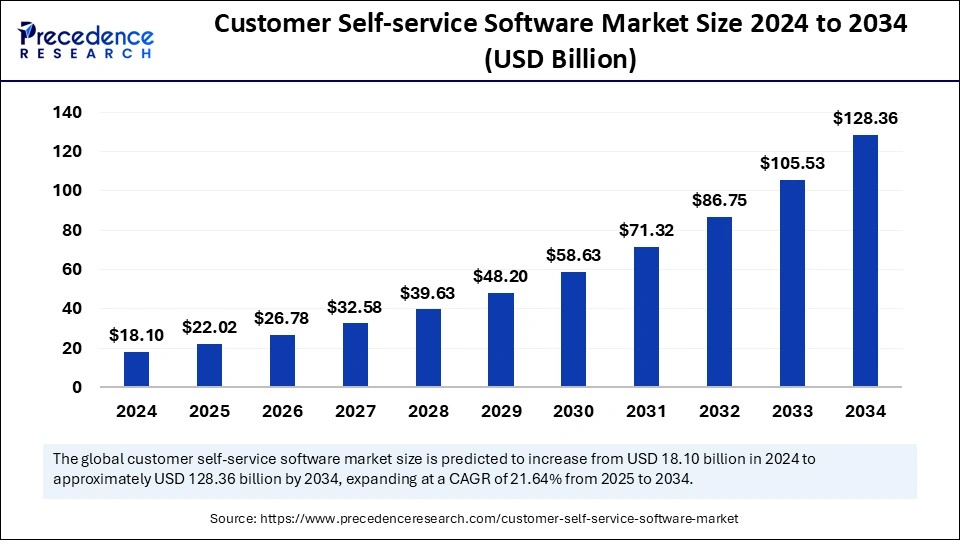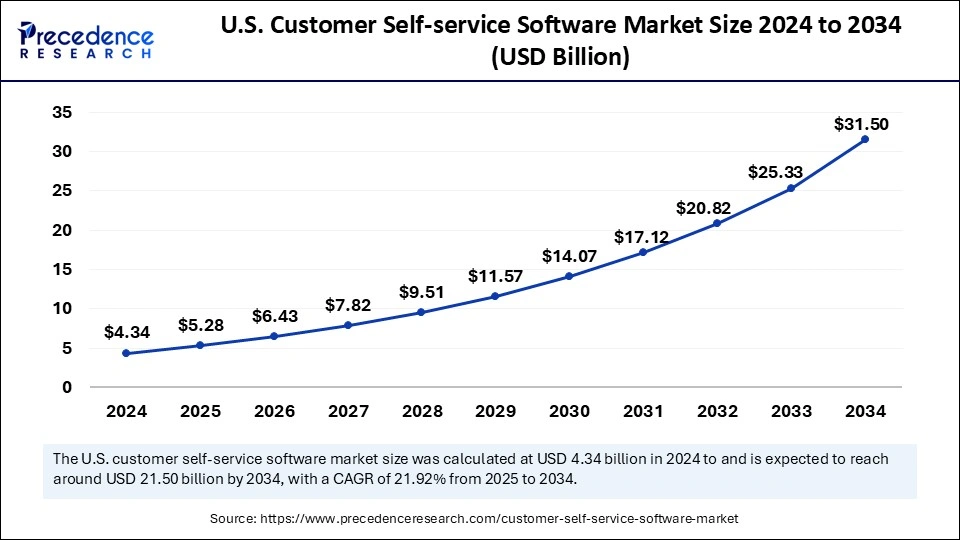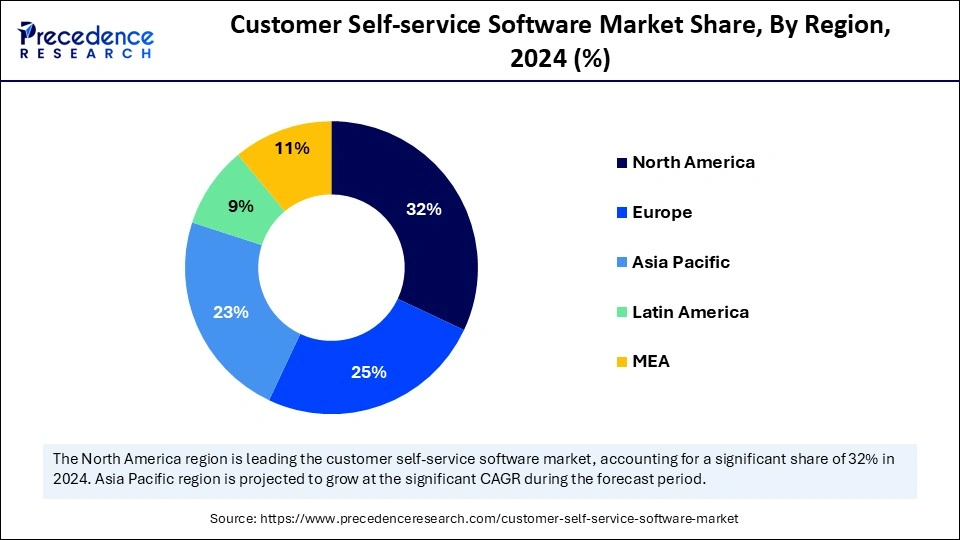February 2025
The global customer self-service software market size is calculated at USD 22.02 billion in 2025 and is forecasted to reach around USD 128.36 billion by 2034, accelerating at a CAGR of 21.64% from 2025 to 2034. The North America market size surpassed USD 5.79 billion in 2024 and is expanding at a CAGR of 21.83% during the forecast period. The market sizing and forecasts are revenue-based (USD Million/Billion), with 2024 as the base year.
The global customer self-service software market size accounted for USD 18.1 billion in 2024 and is predicted to increase from USD 22.02 billion in 2025 to approximately USD 128.36 billion by 2034, expanding at a CAGR of 21.64% from 2025 to 2034. The rising focus of companies to improve their customer satisfaction and loyalty is boosting the growth of the customer self-service software market.

Artificial Intelligence can have a positive impact on the market for customer self-service software. AI technology helps customers resolve their problems in a more independent manner through virtual assistants and chatbots. This minimizes the need for human intervention in customer support while enhancing customer satisfaction. With AI-driven tools, customers can find answers, troubleshoot problems, and continue their work without spending time contacting a human agent. The chatbots and virtual assistants quickly offer solutions and guide the customers to resolve their queries, which helps improve customer satisfaction.
AI-powered customer self-service software helps organizations minimize costs related to customer services that need no human intervention. Integrating AI into the self-service software helps enhance efficiency, convenience, and speed, which leads to immense improvement in the customer experience. AI-driven tools provide 24/7 assistance, ensuring that the customers have service and support when required. AI can help personalize and customize experiences through data analysis and offer more suitable solutions to specific consumers. AI technology boosts customer services, improves brand reputation, and builds trust.
For instance, in March 2025, Cisco launched its Webex AI updates that will be widely available soon. The Cisco AI assistant in Webex Contact Center and the Webex AI Agent will provide self-service customer support.
The U.S. customer self-service software market size was exhibited at USD 4.34 billion in 2024 and is projected to be worth around USD 31.50 billion by 2034, growing at a CAGR of 21.92% from 2025 to 2034.

North America dominated the customer self-service software market by holding the largest share in 2024. The region is expected to sustain its position in the coming years. An increase in the need to improve customer experience and satisfaction is boosting the adoption of customer self-service software in various industries. North American customers are seeking convenient and quick solutions to resolve their issues regarding products or services. The rise in utilization of self-service options like chatbots, virtual assistants, and FAQs further influences the market. The focus of organizations on minimizing operational costs and enhancing efficiency is boosting the adoption of customer self-service software across various industries.
The U.S. plays an important role in the North American customer self-service software market. The strong presence of key market players, such as Microsoft and Salesforce, supports the growth of the market in the country. The well-developed infrastructure and digital transformations of industries contribute to market growth. The increasing usage of cloud-based solutions and growing social media penetration further support market growth. Moreover, the rising emphasis on improving customer experience, brand reputation, and loyalty is contributing to market growth in the country.

Europe is the second-largest shareholder and is predicted to show notable growth during the forecast period. European consumers are seeking ways to solve their queries regarding products and services, which is a major factor boosting the growth of the customer self-service software market in the region. The accessibility and flexibility of this software provide the customers with the necessary information to address their grievances. Organizations in Europe are increasingly offering self-service options through multiple channels like mobile solutions, social media, and company websites to create a seamless experience for the customer, supporting regional market growth.
Asia Pacific is anticipated to witness the fastest growth during the projection period. The rapid pace of digital transformations and modernization in the region is expected to boost the growth of this market. The rise in disposable income and the expansion of the e-commerce sector support market growth. Increased penetration of smartphones and internet services across the Asia Pacific is one of the major factors fueling the market’s growth. With the changing consumer buying behaviors, there is a heightened need to improve consumer experience, encouraging businesses to utilize self-service solutions.
India is expected to have a stronghold on the Asia Pacific customer self-service software market. The rise of e-commerce and the rising investments in digital transformation are expected to fuel market growth. The Indian government is promoting digitization, encouraging businesses and customers alike to adopt self-service solutions. In addition, the rising smartphone penetration contributes to market growth.
The customer self-service software market is experiencing rapid growth due to the increase in demand from businesses for real-time problem-solving solutions to improve customer relationships. This software offers support and helps solve customer’s issues through multiple channels like the web, mobile solutions, social media, etc. Advancements in software solutions led to improved functioning and benefits, aiding this market’s growth. The rising integration of innovative technologies like AI is enhancing the efficiency of the software.
The rising emphasis on building brand reputation and trust through strong customer relationships is a key factor boosting this market’s growth. The rising utilization of smartphones and increasing internet penetration is also helping the market grow. The efforts of digital transformation and modernization of infrastructure around the world will further help the market growth. Many industries are looking to integrate customer self-service software into their infrastructure to improve customer services as well as the overall experience, supporting market growth.
| Report Coverage | Details |
| Market Size by 2034 | USD 128.36 Billion |
| Market Size in 2025 | USD 22.02 Billion |
| Market Size in 2024 | USD 18.1 Billion |
| Market Growth Rate from 2025 to 2034 | CAGR of 21.64% |
| Dominated Region | North America |
| Fastest Growing Market | Asia Pacific |
| Base Year | 2024 |
| Forecast Period | 2025 to 2034 |
| Segments Covered | Solution , Service, End Use, and Regions |
| Regions Covered | North America, Europe, Asia-Pacific, Latin America and Middle East & Africa |
Increased Utilization of Smartphones
The increased utilization of smartphones and tablets is a key factor driving the growth of the customer self-service software market. In 2024, there were 7.2 billion smartphone users worldwide, and this number is expected to increase rapidly over the years. With the rising penetration of the internet, smartphone usage has increased, making it easier for customers to access self-service platforms anytime and anywhere. Almost 94.6% of the world’s population use the internet through their smartphones.
This exponential utilization of smartphones has compelled organizations to offer mobile-friendly solutions for customer services. Smartphones provide enhanced flexibility in accessing services when required, boosting the adoption of customer self-service software across the world. An essentiality of self-service software compatible with smartphone and mobile solutions helps improve the overall customer experience. With the rising usage of smartphones, the market continues to grow.
Lack of Awareness
The lack of awareness among employees and customers about the benefits and functioning of customer self-service software limits the growth of the customer self-service software market. With no proper information and accessibility to information, employees of many smaller or mid-sized organizations are reluctant to integrate this software into their infrastructure. Consumers are not fully aware of how to use self-service software portals. Some organizations often invest in marketing to introduce and make the consumer aware of the features of new software solutions. Such efforts add to costs. Moreover, rising data security and privacy concerns limit the adoption of customer self-service software.
Technological Advancements
The continuous emergence of new technologies, such as artificial intelligence (AI), Internet of Things, blockchain, augmented reality & virtual reality, and machine learning (ML), create immense opportunities in the customer self-service software market. The utilization of these technologies creates an immersive and interactive self-service experience. These technologies also help key players innovate and develop more sophisticated customer self-service software. There can be an enhancement in the personalization and customization of the responses and handling of customer queries through such technology. IoT, for example, can boost the interconnectivity of this software. The utilization of these technologies in the software can enhance the efficiency, functioning, implementation, and customer experience.
The web self-service segment led the customer self-service software market with the largest share in 2024. The steady rise in the demand for these services is mainly because of the increased popularity of digital support. This digital mechanism helps consumers and employees self-assist to find information, resolve common issues, and perform transactions. Enhanced efficiency, as well as the convenience of these solutions, help improve customer experience. Web self-service is being integrated across different industries, supporting segmental growth.
Meanwhile, the virtual assistant segment is expected to grow at the highest CAGR in the coming years. With the rising adoption of AI, the usage of virtual assistants is increasing. This solution is powered by AI, allowing consumers to quickly access support anytime. This, in turn, boosts customer satisfaction and experience.
The professional services segment led the customer self-service software market in 2024. An increase in the usage of analytics, along with AI in automation that helps improve workforce efficiency, bolstered this segment's growth. The issues of configuration and deployment of self-service software are done easily through the professional services segment. Organizations are looking to capitalize on the skills and knowledge of professionals to make the integration of this software effective and smooth.
On the other hand, the managed services segment is projected to grow at the fastest rate over the studied period. The growing demand for outsourcing management and maintenance of such systems to a third party will aid the segment’s growth. Managed services provide businesses with the flexibility to scale self-service capabilities according to requirements.
The cloud segment held the largest share of the market in 2024. The focus and investment in infrastructure development to smoothly integrate advanced technologies bolstered this segment’s growth. The adoption of cloud-based software has increased due to its cost-effectiveness, flexibility, and scalability. Cloud-based solutions are capable of handling customer services as effectively as a human, which enhances customer experience. The convenience of accessing these solutions from anywhere at any time makes them a popular choice.
On the other hand, the on-premises segment is likely to witness the quickest growth in the upcoming period. The rising concerns about data privacy and security are expected to boost the segment’s growth. The integration of these solutions with a developed infrastructure is smoother. Moreover, this deployment enables organizations to have more control, enabling them to scale up or down services according to requirements.
The BFSI segment led the customer self-service software market in 2024. Customer self-service software is being widely utilized in the financial sector because of its efficiency in enhancing consumer services. This software allows finance businesses to provide customers with services as well as information round the clock, helping build trust in the customers. An increase in the need to enhance customer satisfaction and improve operational efficiency while reducing costs will continue aiding this segment’s growth.
Meanwhile, the healthcare segment is anticipated to witness the fastest growth during the projection period. The rising necessity of the healthcare industry to enhance interaction with patients boosts the growth of the segment. Customer self-service software helps healthcare organizations optimize and streamline their interactions with patients and boost efficiency.

By Solution
By Service
By End-use
By Region
For inquiries regarding discounts, bulk purchases, or customization requests, please contact us at sales@precedenceresearch.com
No cookie-cutter, only authentic analysis – take the 1st step to become a Precedence Research client
February 2025
June 2024
November 2024
October 2024